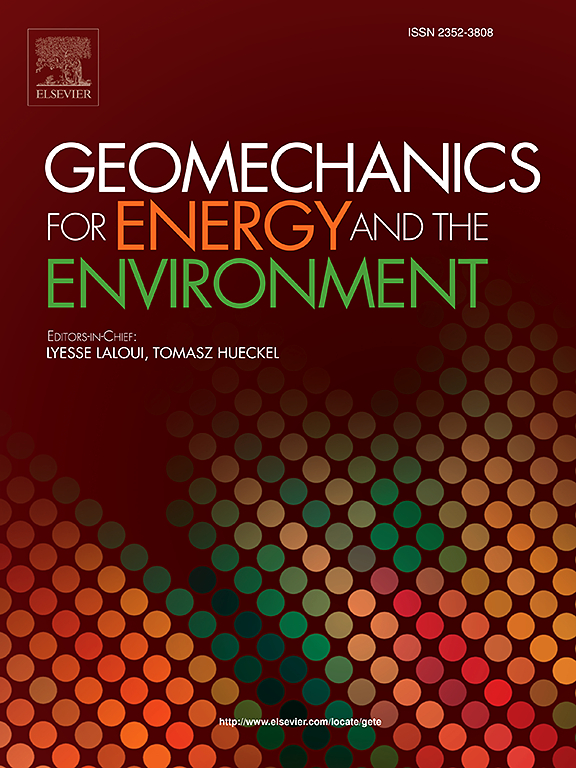mip增强沙漠砂抗风蚀性能:工艺参数优化及微观结构机理
IF 3.7
2区 工程技术
Q3 ENERGY & FUELS
引用次数: 0
摘要
本研究采用微生物诱导碳酸钙沉淀(MICP)技术,从宏观到微观的多尺度研究了沙漠沙地的稳定机理。通过多因素综合分析,建立了提高表面强度、CaCO3含量和凝固层厚度的多目标优化模型。通过风洞试验和保水性试验验证了固化效果。通过x射线衍射(XRD)、扫描电镜(SEM)和原子吸收光谱(PCAS)分析了其微观结构机理。结果表明,MICP工艺的最佳工艺参数为:混合比为1:2.12,胶结液浓度为1.895 mol/L,处理周期为4次。凝固后各项性能指标之间也存在明显的相关性。响应面法优化得到的参数与实验结果基本一致,重复试验结果与优化结果相差小于5 %。在高CSC(单次处理周期)或低CSC(多次处理周期)条件下,micp处理的沙漠砂可以实现高效的固沙和持久的保水。微观分析表明,CSC和Tc的增加改变了颗粒从点到表面的接触方式,孔隙参数与表面强度呈显著负相关。这证明它提高了沙漠砂的保水性和机械强度。本文章由计算机程序翻译,如有差异,请以英文原文为准。
MICP-enhanced wind erosion resistance of desert sand: process parameter optimization and microstructural mechanism
This study employed the microbially induced calcium carbonate precipitation (MICP) technique to investigate the mechanism of desert sand stabilization through a multiscale approach, ranging from macro to micro levels. A multi-objective optimization model was created to enhance surface strength, CaCO3 content, and solidified layer thickness using a comprehensive analysis of multiple factors. The solidification effect was validated with wind tunnel and water retention tests. Microstructural mechanisms were examined through XRD, SEM, and PCAS. Results indicate that the optimum parameters for MICP technology are the 1:2.12 mix ratio, the 1.895 mol/L cementation solution concentration, and 4 treatment cycles. There was also a clear correlation between the performance indexes after solidification. The parameters optimized by the response surface method were essentially the same as those obtained from the experiments, with a difference of less than 5 % between the repeated test results and the optimized results. Under conditions of high CSC (single treatment cycle) or low CSC (multiple treatment cycles), MICP-treated desert sands can achieve highly efficient sand fixation and long-lasting water retention. Microanalysis revealed that increasing CSC and Tc altered the mode of particle contact from point to surface, and a significant negative correlation was observed between pore parameters and surface strength. This proves that it improves the water retention and mechanical strength of desert sand.
求助全文
通过发布文献求助,成功后即可免费获取论文全文。
去求助
来源期刊

Geomechanics for Energy and the Environment
Earth and Planetary Sciences-Geotechnical Engineering and Engineering Geology
CiteScore
5.90
自引率
11.80%
发文量
87
期刊介绍:
The aim of the Journal is to publish research results of the highest quality and of lasting importance on the subject of geomechanics, with the focus on applications to geological energy production and storage, and the interaction of soils and rocks with the natural and engineered environment. Special attention is given to concepts and developments of new energy geotechnologies that comprise intrinsic mechanisms protecting the environment against a potential engineering induced damage, hence warranting sustainable usage of energy resources.
The scope of the journal is broad, including fundamental concepts in geomechanics and mechanics of porous media, the experiments and analysis of novel phenomena and applications. Of special interest are issues resulting from coupling of particular physics, chemistry and biology of external forcings, as well as of pore fluid/gas and minerals to the solid mechanics of the medium skeleton and pore fluid mechanics. The multi-scale and inter-scale interactions between the phenomena and the behavior representations are also of particular interest. Contributions to general theoretical approach to these issues, but of potential reference to geomechanics in its context of energy and the environment are also most welcome.
 求助内容:
求助内容: 应助结果提醒方式:
应助结果提醒方式:


